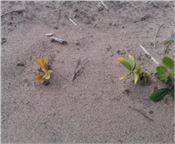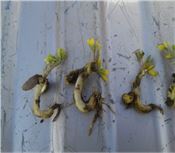Why Peanut Seedlings Have Yellow Leaves
DR. TRAVIS FASKE
LONOKE, ARK.
There have been a few reports of peanut seedlings emerging with yellow or light-brown leaves in a few fields across the state. There are a few reasons for this leaf discoloration; planting seed into cool (<65ºF), wet soils that slows emergence, planting depth, cold weather injury, and prolonged cloudy, rainy conditions during emergence that limits photosynthesis. Based on the weather conditions for the past few weeks, these yellow peanut leaves are likely the result of cool soils that slow emergence and overcast weather. Peanuts are a tropical plant from the region of Peru and Brazil in South America where weather conditions during the growing season are hot, rainfall is adequate, and the days of full sunshine are nearly every day. The critical temperature for peanut is near 40ºF; at this temperature freeze injury can occur on developing seedling leaves. The good news is that these yellow seedlings should make a complete recovery with several days of sunshine and warmer weather.
Due to slow emergence and yellow seedlings some producers have considered replanting, but it is too early to consider replanting for most fields. Peanut seedlings emerge much slower than soybean, corn, or cotton so, they need more time. However, here are some guidelines for overplanting (peanut seed are planted over near existing seedlings) peanuts. First, consider the average plant population; it is recommended to overplant when there are less than 2.5 plants per foot of row. Second, consider the time between planting and overplanting; this should occur within 3 to 4 wk of the initial plant date to minimize significant maturity differences at harvest. It is also recommended to reapply a peanut inoculant when replanting. ∆
DR. TRAVIS FASKE: Extension Plant Pathologist, University of Arkansas

Figure 1a. Peanut seedlings with yellow leaves caused by slow emergence and prolonged cool, cloudy weather.

Figure 1b. Peanut seedlings with yellow leaves caused by slow emergence and prolonged cool, cloudy weather.